Investigating the frozen shores of Antarctica for meteorites preserved in pristine ice.
Investigating the Frozen Shores of Antarctica for Meteorites Preserved in Pristine Ice
Antarctica, with its otherworldly beauty and harsh landscapes, is not only a continent of ice but also a treasure trove for rockhounds and mineral collectors. Among the most sought-after specimens are meteorites, which provide valuable insights into the solar systems formation and evolution. The frozen shores of this remote land serve as exceptional preservation sites for these celestial rocks.
The Unique Ecosystem of Antarctic Meteorite Preservation
The ice-covered landscape of Antarctica functions much like a natural refrigerator for meteorites. extreme cold and lack of substantial weathering processes in certain areas result in incredibly well-preserved specimens, often found embedded in ancient ice or lying exposed on the surface.
Studies have shown that approximately 80% of all meteorites found on the continent belong to specific types: chondrites, achondrites, and metallic meteorites. Notably, the concentration of meteorites in Antarctica is significantly greater than in many other regions of the world. Statistically, scientists believe that the potential yield of meteorites in Antarctica is about 30 times greater than other terrestrial locations.
The Process of Locating Meteorites
The search for meteorites in Antarctica is both systematic and methodical, involving several key steps:
- Field Surveys: Researchers conduct extensive field surveys, often utilizing satellite imagery to identify areas of low snow cover, where meteorites may be exposed.
- Mapping: Areas such as the Transantarctic Mountains and the Allan Hills have been mapped meticulously, showing significant meteorite concentrations.
- Expeditions: Scientific teams are deployed on foot or via specialized vehicles, employing tools like metal detectors and GPS to locate and catalog meteorites.
For example, a renowned location, the Allan Hills, has yielded over 20% of the world’s Antarctic meteorite finds, underscoring its importance for collectors.
Types of Meteorites Found in Antarctica
The varieties of meteorites found in Antarctica are as diverse as they are fascinating. Key categories include:
- Chondrites: Stony meteorites that contain small, round particles called chondrules. The most common type, representing about 85% of all meteorites.
- Achondrites: Igneous rocks that have undergone differentiation. They provide clues about the history of their parent bodies.
- Iron Meteorites: Composed mainly of iron and nickel, these meteorites are often the remnants of the cores of differentiated asteroids.
Real-World Applications and Scientific Importance
Meteorites collected from Antarctica serve critical roles in both scientific research and education. contribute to our understanding of:
- Planetary Formation: Studying their composition helps scientists reconstruct the early solar system environment.
- Space Weathering: Meteorites provide insights into the effects of cosmic rays and solar winds on their surfaces.
Also, notable meteorological data collected near these sites enhances models of climate change and its impact on Earths environments.
Practical Tips for Rockhounds and Collectors
If you are a rockhound or mineral collector interested in meteorites, consider the following practical tips:
- Join a Meteorite Hunting Expedition: Many organizations run guided expeditions to Antarctica, where you can gain firsthand experience in meteorite collection.
- Invest in Proper Tools: Equip yourself with a GPS device, metal detector, and sample collection tools to boost your chances of success.
- Educate Yourself: Familiarizing yourself with meteorite identification and classification can significantly enhance your collection strategy.
Conclusion
Investigating the frozen shores of Antarctica for meteorites offers a unique and rewarding experience for rockhounds and mineral collectors. With its pristine environment, this remote continent presents a rare opportunity to acquire samples that hold keys to understanding our universe. As you consider embarking on this exciting journey, remember to respect the Antarctic environment and adhere to scientific protocols in preserving these precious artifacts.



